|
|
Glenelg

|
|
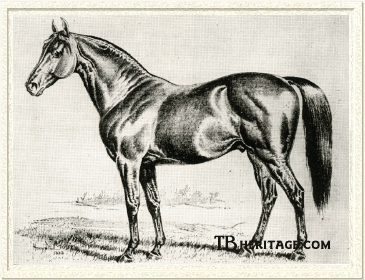 |
|
|
Glenelg, the son of two English horses of no note, became one of the best older racehorses of his time in the U.S., and was champion sire four times, infusing soundness and durability in American thoroughbreds of the late nineteenth century, and getting some of the most notable fillies ever to run on the American turf.
Glenelg's sire, Citadel, was "...more conspicuous in the show ring than on the race course." He was well-bred enough, being by "the Emperor of Stallions," Stockwell, and out of Sortie (1851), a Melbourne daughter, who was out of Escalde by Touchstone. Sortie had been a decent race mare for Lord Derby, running second in Goodwood's Ham Stakes as a juvenile. In Derby's stud she was bred five years in succession to Stockwell; Citadel was the first of her Stockwell foals. Citadel's younger sister, Repulse (1863) won the One Thousand Guineas, the Richmond Cup and the Zetland Plate, among other races.
Glenelg's dam, Babta (1858), was bred by Sir J.B. Mill, from the Defence daughter Alice Lowe, who he had purchased from Thomas King in 1854; after Babta's birth Alice was covered by the Bay Middleton son Autocrat, and sold at auction. Alice Lowe's sire, Defence (1824) was by the great stallion Whalebone. Defence broke down in his first race, the Derby, but became a successful stallion and noted source of stamina, getting the Ascot Gold Cup winner and great French sire The Emperor and Oaks winner Deception, among other good winners, and was broodmare sire of three Derby winners and an Oaks winner. Babta's sire, Kingston (by Venison), was a top stayer, winner of the Goodwood Cup, Epsom Cup and second to West Australian in the Ascot Gold Cup; he got the excellent race mare and broodmare Queen Bertha, 1862 Derby winner Caractacus, and had a reputation as a notable broodmare sire with such daughters as Silverhair, dam of the dual-classic winner Silvio.
In 1864 and 1865 Babta produced two foals by the indifferent Marionette for a Mr. Stollery, and was then bred to Citadel. She was sold, in foal, to the British-born (Sir) Roderick W. Cameron, owner of the Australian Steamship line, and founding member of the American Jockey Club, who had moved to Staten Island, New York, in 1852. Cameron shipped her, the Voltigeur son Hartington, who had won the Cesarewitch in 1862, and another horse he picked up in England, the great Leamington (later four-time leading sire in the U.S.), to America. Leamington was loaned to General Abe Buford to stand at stud at Bosque Bonita Stud in Kentucky, but Babta went directly to Cameron's Clifton Stud on Staten Island, where, the next year, she dropped Glenelg.
Glenelg was a sturdy blood bay, without a mark of white on him. In November of 1867, when he was a long yearling, he was included in a sale of Cameron-bred youngsters. August Belmont, who represented the Rothschild banking interests in New York and was another founding member of the Jockey Club, sent his trainer, Jacob Pincus (who would later train the famous Iroquois) to the sale with instructions to buy the "big bay yearling out of the Kingston mare." He secured the colt for Belmont for $2,000. In 1870, when it was clear just how superior Glenelg was on the track, Belmont purchased Babta, who had since had two foals by Leamington. After that she was bred to Belmont's Lexington son, Kentucky, for five successive years, producing four foals, and then to Belmont's imported stallion, The Ill-Used. None of her succeeding foals were as good as Glenelg, however his half-sister, Cleopatra (1871, by Kentucky), a good runner in her own right, became third dam of the great turn-of-the-century American champion, Africander (1900, by Star Ruby).
Glenelg on the Turf
Glenelg was a growthy youngster, "so big and raw," and highly temperamental at age two, that he did not run as a juvenile. He matured to 16 hands, with a 76 inch girth, and was heavily muscled, short-backed, with powerful quarters and gaskins, and slightly cow-hocked.
He was periodically plagued with colic, which led to some losses and forfeits. Despite this, he ended up the champion three year old colt in the east, with Herzog, the ill-fated Vandal son, the champion in the "west."
Glenelg's first start was the 1869 Belmont Stakes: his competition included his stablemate, Belmont's colt Fenian, by his stallion Mickey Free. Belmont had determined to win with Fenian, and it was with great difficulty that Glenelg was kept by his jockey from winning the race --- "he almost had to pull his head off." He went on to win the Jerome Handicap Stakes (1 mile heats), beating Vespucius after the first heat, but a few days later ran second to Vespucius in the Annual. After that he won the Travers over 1-3/4 miles. He won once more that season, ending with a record of three wins and two seconds in five starts.
The next season he ran erratically, but won some big distance races impressively. In the Westchester Cup at Jerome Park, early in the season, he ran a bad third, shortly thereafter experiencing one of his periodic bouts with colic. He ran third to Helmbold and Hamburg in the 2-1/4 mile Saratoga Cup, but beat Helmbold soundly in Jerome Park's Maturity Stakes over 3 miles. He won Saratoga's Excelsior Stakes (beating Maggie B.B.), which he delayed for an hour by misbehaving. At Baltimore he won the Breakfast Stakes and, most impressively the Bowie Stakes, run in four mile heats, where he beat a very good field that included Niagra, Abdel Kader, and Plantagenet. This win cemented his claim to the championship for older horses.
At age 5 Glenelg started as favorite in the Westchester Cup at Jerome Park, but was beaten by a last second "Chifney rush" by Preakness. He came out of the race lame, and was sent home for treatment, missing the Saratoga Cup to which Belmont sent Kingfisher in his place. Longfellow won that race, and Kingfisher, also lamed, joined Glenelg on the casualty list. That winter both Glenelg and Kingfisher, "magnificent cripples," were turned out in the snowy pastures of Saratoga to recuperate, but although Kingfisher returned to the track, Glenelg's racing days were over.
Glenelg in the Stud
Belmont's Nursery Stud at Babylon, Long Island, had a small number of mares selected for breeding to Belmont's stallion, Kentucky, purchased by Belmont for the huge sum of $15,000 in 1868, which made Glenelg superfluous. Still, he had at least one season there, before being sold in 1872 to Milton H. Sanford for $10,000, the price including two mares, Finesse and Ulrica. At Sanford's 544 acre Preakness Stud in Kentucky, where he joined the ailing Baywood, and, at the time, the little regarded Virgil (later sold and then repurchased), he had access to daughters of Lexington and Australian, and he was almost an instant success. The gelded MONITOR, out of a Lexington mare and the siblings IDALIA (Juvenile Stakes), CARLEY B. (Travers Stakes), WADE HAMPTON and DAN SPARLING (Withers Stakes), all out of Lexington's daughter Item, were early winners for him.
It wasn't until Glenelg passed into Daniel Swigert's hands, however, that he really took off as a stallion. Swigert had worked for R.A. Alexander at Woodburn and then on his own account at his own Stockwood Farm, developing and selling young horses (the aforementioned Kingfisher was one). Swigert purchased Preakness Stud in 1881, renaming it Elmendorf; included in the price was Glenelg, and also Virgil, who had by then established his credentials as a stallion with Vagrant, Virginius and Swigert's own Hindoo. While most of Glenelg's good runners were from Lexington mares, his very best, FIRENZI, was out of a Virgil daughter, bred by Swigert in 1884.
Between 1876 and 1888 Glenelg had 428 starters winning 997 races worth $843,233. In Swigert's ownership Glenelg led the sires' list four times -- 1884, 1885, 1886 and 1888 -- the first horse to clearly dominate the charts since Lexington. He had four youngsters that won over 40 races each -- LITTLE MINCH, GLEANER, FIRENZI, and LOS ANGELES -- 228 races won by four horses, got by one sire. It was not for nothing that the phrase "Glenelgs for soundness" was repeated on breeders' lips. His offspring had "wonderfully good legs and feet," were of "sterling constitution and stamina," were game, and had speed.
He got some good running sons, but it was his daughters that cemented his name a sire of racehorses. Likewise in the stud: he did not get a sire son of merit, but he got outstanding broodmares, and it is through his daughters that his name descends into pedigrees of today.
It was not from Kentucky, but from California, that his influence on contemporary thoroughbreds is most felt. His daughter, CLARA D. (1875, out of The Nun, by Lexington), was purchased, along with a half-dozen other daughters of his for E.J. "Lucky" Baldwin's Rancho Santa Anita in southern California to breed to Baldwin's stallions Grinstead and Emperor of Norfolk. One of Clara D.'s foals, by Emperor of Norfolk, was the in-bred, speedy Rey del Caredes, later named Americus, who went to England and got Americus Girl and Lady Americus, and so gave the breed Fair Trial, Tudor Minstrel, Abernant, Mumtaz Mahal, Nasrullah and the rest. Clara D., to the cover of Grinstead, also produced the beautiful brown colt Santiago (1887), winner of the Drexel and Sheridan Stakes in Chicago, and second in the American Derby, a winner of over $25,000, and later a stallion at Rancho Santa Anita. Clara D.'s sister, SISTER ANNE, produced Volante (1882, by Grinstead), winner of the American Derby and dozens of other sweepstakes for Baldwin.
Through his daughter GLENLUINE (1874, out of Lute, by Lexington) Glenelg is also seen in the pedigree of the great 1940s handicapper John's Joy (1946, by Bull Dog), winner of 19 races, later a moderately good sire. Through daughter HEEL AND TOE (1880, out of La Polka by Lexington), he was in the pedigree of imported Aethelstan (1922, by Teddy and from Dedicace), a winner in France and third and fourth on the sires list there in the 1930s before he was brought to the U.S.; a failure at stud in the U.S., but he is still seen in some pedigrees today through his great French racing son Maurepas, who died young, and through U.S. son Bel Aethel and his sister Diane de Poitiers (both from the outstanding broodmare Plucky Liege). Another daughter, FERIDA (1876, from La Henderson, by Lexington) was tail-female ancestress of Habitat and Dancer's Image, and also through her sister, AELLA, in the pedigree of the great American champion Stymie, Glenelg is in the pedigrees of present day stakes winners.
In October of 1891 Swigert's Elmendorf stud was dispersed; James Ben Ali Haggin, who had made his fortune in California and had owned Rancho del Paso, the world's largest thoroughbred stud farm there, purchased Elmendorf a few years later from C.J. Enright, and spent a fortune upgrading it. Haggin began to dispose of his California bloodstock, which numbered in the hundreds, at auctions in California and New York, buying back some stallions and mares as seed for his new Kentucky farm. Several Glenelg daughters were in Haggin's Rancho del Paso stud, the most notable being the great FIRENZI, whom Haggin had purchased as a youngster from Swigert. She was consistently put to Haggin's champion Salvator (who had also been bred at Elmendorf by Swigert), but the cross did not ever produce the blockbuster runner for which Haggin had been hoping. She died before Haggin made the move to Kentucky. Another Glenelg mare at Rancho del Paso was PRECIOSA (1883, from Stamps, by Lexington). Like Firenzi, she produced some California stakes winners, but nothing that made the national scene.
Some of Glenelg's best are listed here.
The Lexington daughter Item, a sister to Tom Ochiltree (1872, winner of the Preakness, Dixie Handicap and Saratoga Cup) bred four good horses by Glenelg. IDALIA (1874) won the Juvenile Stakes and at age three Jerome Park's Ladies Handicap, as well as other races. DAN SPARLING (1876), named for a jockey, was a modest juvenile, third in Morris Park's Champagne Stakes, but went on at three to win the Withers Stakes. CARLEY B. (1879) was gelded; he won the Travers Stakes and other good races. WADE HAMPTON (1875) was also a winner, although at a lower level of racing.
The Lexington daughter Lute produced GLENLUINE (1874). She was bred by Swigert and sold to R.A. Alexander, for whom she produced Troubador, by imp. Lisbon. Troubadour was sold to Swigert for $400, and after winning for him once as a juvenile, was sold to Milton Young, winning the Criterion Stakes at Chicago and three stakes at Latonia in the fall, and the next year taking the Charles Green and St. Leger Stakes (St. Louis) and the Palmer House Stakes (Chicago). He was then sold to Captain S.S. Brown of Pittsburgh, in whose hands he developed into a first-class horse. A dark bay with a star and ship and four white feet, he was erratic as a juvenile, alternatively brilliant and terrible, winning seven of his fourteen starts. At age three he started 21 times, won five. At age four he became a star by winning all three of his races: the Latonia over 1-1/4 miles; the Suburban, in which he took the lead and was never headed, winning by four lengths from Joe Cotton, Ban Fox and others in an excellent field; and finally, a special race against the great Miss Woodford over 1-1/4 miles, which he won by half a length. The next year, age five, he won the Ocean Stakes and Monmouth Cup and two other races; he and The Bard were considered the best of that season. He later became a stallion of some note; son Daily America, won the Lawrence Realization in 1893, the same year his son Lookout won the Kentucky Derby,and a daughter, Ethel Pace, produced 1921 Withers Stakes winner Leonard II.
GLENLUINE was also the dam of School-Girl (1881), by Pat Malloy. In James Ben Ali Haggin's Rancho del Paso stud in California, School-Girl produced Lucania (1892), who won the Withers Stakes, and Pupil (1897), winner of the National Stallion Stakes, both by Haggin's New Zealand-bred stallion Sir Modred. As noted earlier, the 1940s handicapper John's Joy descended from Glenluine.
Another Lexington daughter, Stamps, a good performer on the turf, produced the filly BERTHA (1875) to the cover of Glenelg; she was second dam of the wonderful Rayon d'Or filly Souffle (1893), winner of the Kentucky Oaks, Latonia Oaks and Jercome Handicap. But it was her sister, LOUISETTE (1881), a handsome filly purchased by George Lorillard, who was the best of the cross: she won $36,440 from 59 starts, which included 19 wins and the three-year-old championship for fillies. Her wins included the September and Hunter Stakes. Another sister, PRECIOSA (1883), was another good runner, winner of a juvenile race at Monmouth, beating Dry Monopole and ten others, and of the Autumn Stakes for two year olds, beating the The Bard, Ben Ali, Blue Wing and other youngsters that went on to glory. At age two she was also second in the July Stakes, third in the Hopeful Stakes (beating The Bard), and second in the Criterion Stakes; she won five races at age three, and was also a winner at age four. In Haggin's Rancho del Paso stud she produced My Nettie, a winner; stakes winner Uncle Jess, who became a sire in California; the unraced Maxio (by imported Maxim), who got some winners as a stallion at Rancho del Paso; and three other winners in California.
|

Monitor
| |
MONITOR (1876, from Minx, by Lexington), was one of Glenelg's unruly colts, and he was gelded at age two, after which he settled down to a nice career on the turf. His wins included the Jerome Handicap and the Dixie Handicap, and he ran second to Spendthrift in the Belmont Stakes, and was second in the Saratoga Cup. As a four year old, he was the champion older horse in the U.S. His sister, LOTTA C. (1878), was dam of Clifton Forge (1901, by Handsome), winner of the Bayview Handicap. Toboggan Handicap winner Lion d'Or (1916, by Heno) descended tail-female from Lotta C.
|
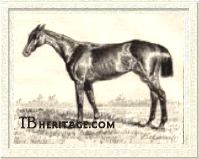
Ferida
| |
FERIDA (1876, from La Henderson, by Lexington) was a small, game mare. She was an indifferent runner as a juvenile, but raced very well between the ages of three and five, winning the Alabama Stakes, the Monmouth Oaks, and the 1-1/2 mile Ladies Handicap at Belmont Park, among other races. In the New Jersey stud of the (David) Gideon- (Marcus) Daly partnership she produced two good daughters, both by Sensation. Carrie C. (1887) became the dam of Jean Beraud (1896), winner of the Belmont and Withers Stakes, among others, and Medje (1884) bred on: American Derby winner Fighting Step (1942), the stallion Habitat (1966), and Wood Memorial Stakes winner Dancer's Image (1965) were among her good descendants.
|
| Ferida's sister, AELLA (1878) also won the Ladies Handicap and other races. Her offspring included Prince George (1886, by Sensation), winner of the Carlton Stakes and the Toboggan Handicap, Senella (by Sensation), who won the Juvenile Stakes, and The Great Ruby (1900, by Star Ruby or Artillery), second dam of the Colin son On Watch (1917), winner of 21 races, including some high class handicaps and later dam's sire of the American champion Stymie (1941), and also grandsire of champion High Gun. Through Stymie, Glenelg is in the pedigree of good stakes winners today. Ferida's and Aella's dam, La Henderson, also produced Vanguard, winner of the Preakness Stakes, and another good runner, Virgilus, both by Virgil.
|
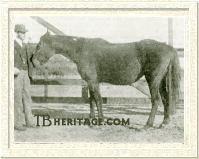
Sister Anne at age 23, pensioned at Rancho Santa Anita
| |
CLARA D. (1875, from The Nun, by Lexington) was bred by Sanford and sold to Lucky Baldwin. In California she became the dam of Americus, as noted above.
Her sister, SISTER ANNE (1876), also purchased for Rancho Santa Anita, produced Volante, Maria Stuart and Estrella, all stakes winners. The tail-female lines of the mares persisted in California for some years.
|
| American Derby winner Volante's trainer, Albert Cooper, always referred to as that "leetle fat hoss," because no matter how hard he worked, he remained plump, easily carried by his enormous bone and huge muscles. Volante won 35 of his 84 races, with 28 seconds, and was unplaced only nine times. His wins during his five seasons on the turf included the Saratoga Cup, the Brewers Cup, the Champion Stakes, and the Merchant Stakes, beating all the stars of his day. Volante went to stud in Kentucky, but was only a modest sire.
|
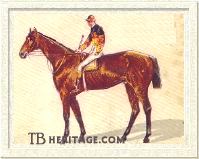
Dry Monopole
| |
DRY MONOPOLE (1883, from Peru, by Glengarry) was a small, athletic horse. He did nothing as a juvenile, but at age three won ten of his 25 races; his most impressive win was the Brooklyn Handicap, where he beat Hidalgo and Blue Wing "on sheer gameness."
|
LITTLE MINCH (1880, from Goldstone, by Loadstone), bred by Swigert, was one of Glenelg's sturdiest runners. She had 221 starts in her career, and won 84, with earnings of $56,963. One of her wins was the Merchants' Stakes. There is no record of any produce from her in the American Stud Book.
POWHATTAN II (1881, from Florence, by Australian) ran in top company and won races, including the 2 mile Kenner Stakes. He was third to General Miles in the Saratoga Cup and to Drake Carter in the U.S. Hotel Stakes. He was half-brother to the great runner Parole. Powhattan's daughter, Push, was dam of the 1904 American Grand National Steeplechase winner, Landslide.
Another Australian daughter, Malta (from Miriam, a Lexington daughter), produced Glenelg's daughter GRISETTA (1884). At age two she won the Spinaway Stakes and the Hyde Park Stakes. At age three she took the Alabama Stakes, and was third in the U.S. Hotel Stakes to Hanover. Malta's sister, Malaga, produced MANOLA (1882) to the cover of Glenelg; she later bred Kentucky Oaks winner Etta (1897, by Falsetto).
La Polka, by Lexington, who had done well on the turf, was in Swigert's stud. She was bred almost exclusively to Glenelg, with the exception of two years, when she was put to Virgil. Her first three sons by Glenelg, POST-GUARD (1874, aka General Phillips) and DANCING-MASTER (1875), and STRATHSPEY (1878) were good winners. Post-Guard was later a stallion in the Hurricana Stud in New York.
La Polka's 1880 Glenelg filly, HEEL-AND-TOE, was a good distance mare, winner of 21 races in 107 starts, with earnings of $17,934. Heel-and-Toe was later dam of The BardGold Heels (1898, by The Bard), a top runner who won the Chappaqua Handicap at age two, one of five wins in 24 starts. At age three he won 7 of his 12 starts, including the Long Island Handicap, the Oriental Handicap, and the Morris Park weight-for-age stakes. At age 4 he was the champion older horse, winning four of his five races, including Brighton Cup over 2-1/4 miles, the Brighton Handicap, and the Suburban Handicap, carrying top weight.
Heel-and-Toe also produced the filly Come-and-Go (1888, by Alarm), who was dam of Astoria Stakes winner Ocean Tide (1901, by St. George), and tail-female ancestress of French runner and sire Aethelstan (1922), Italian crack Sang Bleu (1969), and a number of other good winners.
|

Los Angeles at age 14
| |
La Polka's best runner was Glenelg's outstanding daughter LOS ANGELES (1885), who was purchased as a yearling for $3,500 from Swigert by Lucky Baldwin. She was a "wasp-waisted, fine-drawn, high-strung racing machine," seemingly "made of whalebone and steel." Over five seasons she won 48 races in 110 starts, at distances from 5 furlongs to two miles, in all conditions and carrying all weights, earning around $100,000 in the process. Her wins as a juvenile included the Spinaway Stakes. At age three she started by winning the Vestal and Triboulet Stakes in San Francisco, then headed east, stopping in Denver to win the South Park Stakes, in Cincinnati to win the Latonia Derby and Kansas City Oaks, and then to big wins in New York, winning the Foxhall and Kenner Stakes at Saratoga, the Jersey Handicap, a sweepstakes at Brooklyn, and the Pocahontas and Monmouth Oaks at Monmouth.
|
| That busy year she also won the Tyro Stakes, ran second in the Kentucky Oaks, second in the Alabama Stakes, second in the Second Special at Gravesend, and third in the American Derby. Her later wins included the Second Special in 1890, the Saratoga Cup in 1891, and the 3/4 mile Congress Hall Stakes three years in succession. Her iron constitution finally gave way, and she was retired to the breeding shed in 1891, Baldwin having turned down a $10,000 offer from Leland Stanford, who wanted her for his Palo Alto Stud. She stayed in California until 1902, when Baldwin sold her for $10,000 to J.J. Chanley of Jersey City, and at age seventeen she was shipped east to A.J. Cassatt's Chesterbrook stud farm in Pennsylvania where she was bred to the great racehorse but modest stallion The Bard. When The Bard went to Woodburn Farm in Kentucky (still in Cassatt's ownership) in 1906-07, Los Angeles also went there, breeding three foals by The Bard in total in successive years. She did not produce any high class runners, by The Bard or any other stallion, on either coast.
|
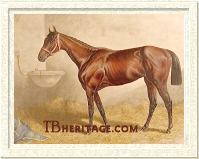
Firenzi
| |
Glenelg's most famous winner was the game little bay mare FIRENZI (1884, also spelled Firenze), who was out of Virgil's daughter, Florida, sister to Hindoo. She assumed the mantle of "Queen of the Turf" from Miss Woodford, beating every horse she met, "if not the first time, then the second." Like Los Angeles, she was purchased from Swigert, this time by northern Californian James Ben Ali Haggin. She traveled everywhere in the east, winning 47 of her 82 starts, and over $112,000 (the second American filly, after Miss Woodford, ever to win over $100,000); she was champion three-year-old filly, and champion handicap mare at ages 4, 5 and 6.
|
At age two she won the Nursery Stakes, the Ladies Handicap, and several other races. At three, she won all the big stakes for fillies, including the Monmouth Oaks and the Gazelle Handicap, as well as the Jerome Handicap (beating Hanover). Her other wins included the Monmouth Cup (twice), the Monmouth Handicap, the Champlin Stakes, the Freehold Stakes (twice), and the Harvest Handicap (all at Monmouth); the Manhattan Handicap and Battle Stakes at Jerome Park; the Average Stakes and Great Long Island Stakes at Coney Island, and many more races too numerous to list. She was at her best at distances over 1-1/4 miles.
She was retired to Haggin's Rancho Del Paso stud in California. None of her youngsters were anywhere near her class, but her daughters were good producers and bred on. Her son, Hiero (1895), by Salvator, bred at Rancho del Paso, ran only at age three, winning three races in California, one of them at 1-1/4 miles in 2:09-1/2. He was then put in the Rancho del Paso stud, where he made little mark as a sire. Her filly Pearl V (1894, by Salvator) was dam of Water Pearl (1904, by Watercress), and Golden Pearl (1905, by Golden Garter), all bred at Rancho del Paso. Water Pearl won the Great American Stakes and the Tremont Stakes, and Golden Pearl won the Whirl Stakes. Kentucky Derby winner Paul Jones (1917, by Sea King) was a grandson of her daughter Fiesole (1898, by Goldfinch), and other descendants of Fiesole were stakes winners, including Petrify (1939), winner of the Arlington Lassie Stakes and Matron Stakes. Firenzi died in 1902 at Rancho del Paso.
Firenzi's sister, FLEURETTE (1885) was the dam of the gelded Boots, winner of the Suburban Handicap, and of Little Celt, winner of the Carter Handicap.
Lexington's good-running daughter Sultana produced Glenelg's daughter SHE (1886) in Belmont's Nursery Stud. SHE ran twice, winning the Laurel Stakes, and second in the Willow Stakes.
Glenelg had many other winners and horses that placed well, and successful broodmare daughters. Of his sons, CARLSBAD (1889, from Lady Wayward by Virgil) won the American Derby, and TRISTAN (1885, from the Tom Bowling daughter Traviata) won the Metropolitan Handicap. Of his other daughters, BELINDA (1876) from Madame Dudley, a good running daughter of Lexington's, won the Champagne Stakes and was second in Belmont's Juvenile Stakes at age two. ELKHORN LASS (1879, from Finework, by Lexington) was a winner and ran second in the Jerome Handicap to CARLEY B. CAMMIE F. (1875, from Cordelia by Lexington) was also a good runner, winning the Elkhorn Stakes (beating Himyar), and other races. FAIR LADY (1882), from Fair, by Glen Athol, was the dam of good winners, including Dagonet and Bermuda, the latter winner of the U.S. Hotel Stakes; her tail-female descendants bred on with 20th century stakes winners in France and England. DOLLIE VARDEN (1877), from the Virgil mare Nannie Black, was dam of the good runner Typhoon II (1894), who won the Kentucky Derby and other races. GLEAM (1873, from Maze, by Planet) bred on; Monmouth Oaks winner Dorothy Brown (1943) and her staying son, Santa Anita Handicap and San Juan Capistrano winner Bobby Brocato (1951) descended from Gleam.
When Elmendorf was sold, Glenelg, already in his twenties, but still fertile, was sold to Tyree Bate of Castalian Springs, Tennessee. Glenelg Stud, as Bate's farm was then styled, was the stallion's home until he died on October 23, 1897. Game to the end, Glenelg was still getting foals when all his contemporaries were dead; he had some winners in his crop of 1895, some from the famous Tennessee Belle Meade Stud, in 1896 he got five foals on the ground, and the year of his death there was at least one, GLENELG'S LAST, from Bate's mare Millrace, by Wanderer.
--Patricia Erigero
|
|
|
|

